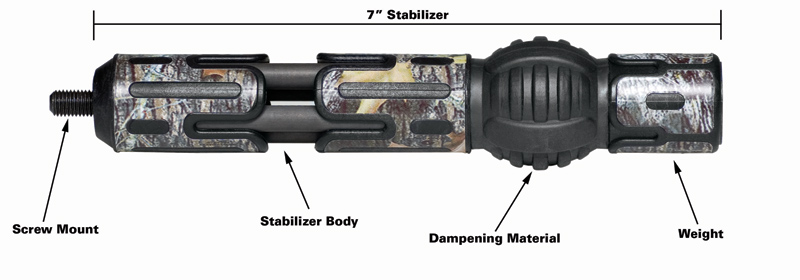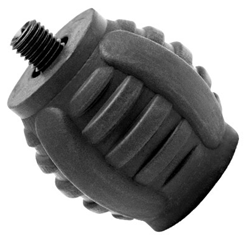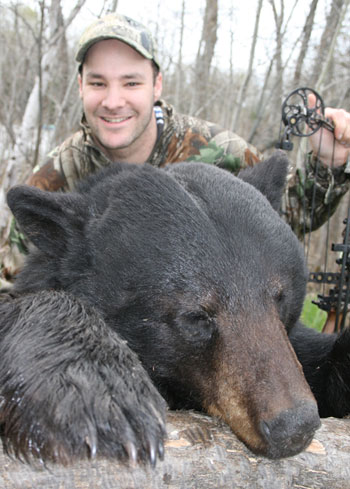I remember the first time I watched an archery tournament. I was amazed at the length of the archers’ stabilizers. Many of the stabilizers that the pros use are very different than the ones used by hunters; they are three-to-four times longer and usually consist of carbon and rubber. Many of the stabilizers found on today’s hottest selling bows are nothing more than a piece of rubber. These small rubber stabilizers are more for looks than actual functionality.
Over the last several years, many bowhunters have been led to believe that a stabilizer has one primary function - eliminating noise and bow vibration. However, the true function of a stabilizer is much more than that. According to Bill Leven, owner of Doinker Stabilizers, vibration dampening is only part of the equation. “There is no question that a stabilizer helps reduce hand shock, bow noise and vibration, but one of the main reasons bowhunters should hunt with a stabilizer is because it helps keep a bow steady and stable when shooting. That’s why it’s called a stabilizer,” Leven explained.
To understand how a stabilizer works, you must first look at what they consist of. At first glance, you will realize that they come in all shapes and sizes. Many of today’s stabilizers incorporate a series of components that are scientifically proven to do their job. Although all stabilizers screw into the bow, some versions employ a more sophisticated anatomy, whereas others can be downright simple. They can be composed of rubber, metal, plastic, or even made using a combination of materials. It is important to note that the materials used and the order in which components are located on a stabilizer have a significant impact on how a stabilizer functions and performs.
View A variety of stabilizers here
ANATOMY OF A STABILIZER
The main body of most stabilizers typically consists of a solid piece of material shaped like a tube. In the past, many stabilizer bodies were made out of metal, despite the fact that metal can be very heavy. Undoubtedly, stabilizers will add weight to a bow. However, you don’t want to add too much weight, and if any weight is to be added, it should be done in the right place. Companies are now using lighter materials such as carbon, ABS plastic and similar materials to make stabilizer bodies as light and rigid as possible. “Carbon is extremely durable and lightweight, making it a perfect material to use when building stabilizers,” Leven stated. Given the fact that carbon rods are thin, rigid, and lightweight, they offer the perfect platform. Additionally, carbon has minimal wind resistance, which becomes increasingly important as the length of a stabilizer increases.

THE VIBRATION AND NOISE DAMPENING COMPONENT
One of the most important ingredients found on a stabilizer is its dampening device. Most companies use a type of rubber, gel or sand to serve as the dampening component. All of these materials sport dampening capability, but if you take note of the many sports equipment manufacturers outside the hunting industry, you recognize that they utilize rubber to reduce vibration, noise, and shock. Baseball bats and tennis racquets are textbook examples. Like bows, they’ve become much more technologically advanced in recent years. However, those manufacturers of top-end bats and racquets still incorporate rubber because there will always be vibration to kill, regardless of how advanced the equipment has become. As such, modern day bows are no different. “Many bowhunters believe that because their bow is smooth and quiet, they don’t need a stabilizer. Bows will always produce some noise and because of that, a stabilizer should always be used,” Leven added.
With a stabilizer, it’s important for dampening to occur where it’s most beneficial and effective. Vibration must be transferred properly away from the bow and out of the stabilizer end. By strategically placing the dampening materials away from the bow end of the stabilizer and toward the portion of the unit furthest away from the bow and after the stabilizer’s body, it will maximize the dampener’s effectiveness.
A WEIGHTED FRONT END
A weight can be found on the front end of many of today’s stabilizers. In order to maximize effectiveness, the weight should come after the rubber material at the end of the stabilizer where it is furthest from the bow. An extremely efficient stabilizer is not set up this way accidentally. The weight is in the front of the stabilizer, serving as a counterbalance, and is what keeps the bow stable when being shot.
This design can also be seen on high-end target rifles, where the stock of the gun is usually lightweight and the barrel is very heavy, helping increase accuracy, effectiveness and aiming. This allows the shooter to aim the gun while the heavy barrel keeps the gun extremely steady. If the entire gun was lightweight, the shooter would have difficulty maintaining a consistent aim. Since the portion of the firearm furthest from the shooter is heavy, the barrel floats around the ten-ring instead of moving erratically. The same premise is true for the stabilizer with a lightweight body and heavy front-end: the weight in the front makes it easier to aim consistently.
A heavy front-end weight combined with a rubber dampener directly behind it is designed so to assist in canceling out vibration. Stabilizers of the past were a solid piece of metal or rubber, and the moment the stabilizer was attached to a bow, they became “one” unit. When a bow is shot with this type of stabilizer, the vibration simply moves from the bow through the stabilizer, which is somewhat effective, but not nearly as effective as it could be. On today’s high-tech stabilizers, the rubber dampener separates the body of the stabilizer from the weighted front-end. When a bow is shot with a modern stabilizer, vibration is cancelled out when it meets the rubber because the weighted front-end is allowed to oscillate at a different frequency than the rest of the stabilizer and bow. This turns the vibration into motion, which does not affect the rest of the bow. Therefore, when selecting a stabilizer, choose one with a weighted front-end that has some type of dampening device directly behind it.
CHOOSING THE RIGHT LENGTH
Another thing to consider is the stabilizer’s length. Target archers use long stabilizers because the extreme length gives tremendous stability while shooting. Bowhunters do not need as long of a stabilizer due to shooting requirements and conditions, but undoubtedly still benefit from what a stabilizer has to offer. Still, many hunters say, “I’m hunting and all I need to do is shoot X amount of yards so my set-up doesn’t need to be as critical as a guy who shoots competition archery.” However, with all things considered, shouldn’t it more important that we be as accurate as possible? After all, we owe it to the animals we hunt to give them the respect of a quick and humane kill.
 |
 |
| A Short Stabilizer is preferred for hunting and even this small 1" stabilizer can help. Close range bowhunters tend to go for this size. |
 |
| A longer Stabilizer is preferred for shooting and is more effective however is not always good for shooting from stands and blinds. Western Bowhunters tend to prefer this style. |
Today’s hunting bows are much shorter and lighter than competition bows, with many having axle-to-axle lengths of 35 inches or less. Reflex limbs are also found on nearly every new bow in the marketplace. For these modern bows, a long stabilizer is overkill. Instead, a stabilizer in the 4-to-10 inch range will be effective, functional, and certainly practical for nearly any bowhunting scenario. Adding a well-built 6-inch stabilizer to a properly tuned bow will, in many cases, result in smaller arrow groups. Other benefits include reduced hand shock and bow vibration, minimized torque, and decreased noise. Scientists and experts who test bow noise and vibration know that bows will always produce noise, but agree that by adding a quality stabilizer, you can reap many benefits.
CUSTOMIZE IT
One of the most important things to consider when deciding on which type of stabilizer to purchase is whether or not it can be customized. “I think many bowhunters just buy the first stabilizer they pick up. Bowhunters should base their decision of which stabilizer to purchase on how well they shoot with it. Bowhunters would never dream of buying a bow without shooting it. They should feel the same way about a stabilizer,” Leven advised. Not every archer shoots the same. Some archers like a stabilizer that is very heavy in the front. Others prefer one that has just enough weight in the front to add some stability. Having a stabilizer that you can add weight or length to is a smart way to ensure that it can be used for a variety of applications. Bowhunters who have this type of stabilizer often lighten the unit when bowhunting, and conversely add weight to it when shooting a 3-D course.
Purchasing a stabilizer that can be customized costs only a small amount more than an inexpensive stabilizer made of nothing more than a piece of rubber, but as the saying goes - you get what you pay for. Just like all sports, bowhunters prefer set-ups that fit them and their needs, so it’s important to figure out what size and style is best. For example, a 5-inch stabilizer might work for a friend, but you may benefit more from a 7-inch stabilizer with a slightly heftier weight. Bow length, shooting form, and the kinds of hunting you do all plays a role in the type of stabilizer that should be used. Treestand hunters typically need a short, easy-to-maneuver stabilizer. Hunters who take long-distance shots out west typically need a longer, heavier stabilizer. Whatever the case, be smart and invest some time into your search for a stabilizer; it could prove to be more of a difference-maker than you realize.
Regardless of which brand of stabilizer you choose, remember to purchase one that sports a lightweight body, an effective dampener, and a weighted front-end. In the simplest of terms, purchasing one with these key ingredients will help you become a better shooter. Purchasing a poorly-designed stabilizer is like buying chocolate chip cookies without the chocolate chips - something is missing!
If you are still on the fence about whether or not you need a stabilizer, remember that pro and staff shooters who hit quarters at 80 yards use a stabilizer when they bowhunt, simply because it makes sense! As long as bows make noise, whitetails will jump strings. And, as long as whitetails jump strings, we should always be searching for a quieter, more accurate bow. One proven way to do that is by adding a high quality stabilizer.

About Tracy Breen
|
Tracy Breen makes his living as an Outdoor Writer. In the past several years, he has been blessed to hunt and fish all over North America and at twenty seven years old, he has been able to do things he never thought were possible. This is part of what makes his story unique. In addition to being a diehard outdoorsman, Tracy has cerebral palsy; a disease that affects much of his right side. The possibility of a guy in his twenties with a disability making a living in the hunting industry is almost impossible… unless Christ opens those doors.
When Tracy gives his testimony at outdoor events, he shares hunting techniques and discusses some of the adventures he has had. He also talks about his struggles and disappointments that he has had to deal with while growing up with health problems. He shares how God has used his life and opened many doors that have brought him where he is today. All things are possible through Christ and if you “delight yourself in the Lord and he will give you the desires of your heart.” (Psalm 37:4) This is what he hopes all people who attend his events will know when they leave. Yes, Tracy gets to hunt all over. Yes, he can teach people how to kill a turkey with a bow. However, more importantly, Christ has opened all of the doors and has allowed Tracy to overcome the struggles that could have destroyed him if it weren’t for Christ.
Tracy usually speaks for about an hour on turkey hunting with a bow and Western elk hunting. He then gives his testimony and ties everything together with a power point presentation to keep things moving and keep the audience interested until the end of the event.
Tracy lives in Muskegon, Michigan with his wife, Angie. He currently writes for most well-known hunting publications and numerous Great Lakes publications. Tracy is the Editor of the God’s Great Outdoors E-zine. Tracy is on the Mathews Archery Pro-staff.
|
 |
Doinker Stabilizers
The King of all Stabilizers. Come visit the Doinker Online Castle often to view monthly specials and a wealth of new features to help you with your hunting and shooting! Doinker is a proud sponsor of Bowsite.com.
|